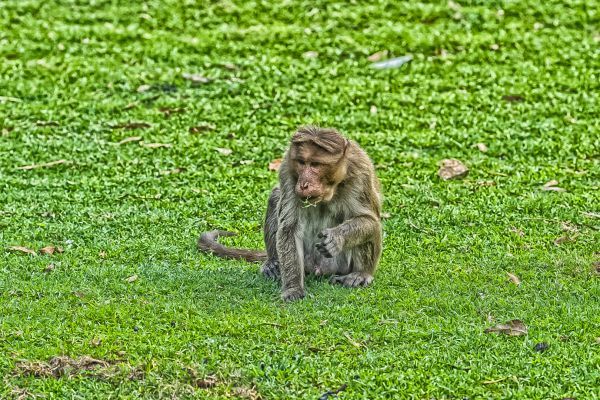As if in a wide canvas nature itself creates animals surrounded by a vivid ecosystem. The sambar deer belongs to a large deer family in India, and conservationists list it as vulnerable. The appearance and size of sambar deer vary widely across their range. The large, rugged antlers typically ruin, with the brow tines being simple and the beam forked at the tip, resulting in only three tines. The antlers are typically up to long in adult individuals. As with most deer, only the males have antlers. The shaggy cost can be from yellowish brown to dark grey colour, and while it is usually uniform in color, some sub-species have chestnut marks on the rump and underparts. The tail is relatively long for deer, and generally black above with a whitish underside.

Vulnerable Sambar Deer and Endangered Wild Water Buffalo
This picture shows a Sambar deer with its nose injured from a tiger attack. As we are ssing it in the picture the inured nose in criticially infected. If not treated, the condition worsens slowly. The animal faces death due to the fatal wounds. We can observe Sambar deer in almost all wildlife sanctuaries of India. As they are all very meek in nature, usually attacked by other animals. I have taken nice moments of photographs in the Ranthanmbore wild life national park. The last moments of slow and silent death of sambar deer was a pathetic sight.
Conservationists list the wild water buffalo, also called the Asian buffalo, as endangered, with the remaining population totaling less than 4,000. Wild water buffalo surpass domestic buffalo in size and weight.
Their skin color varies from gray to black. Their moderately long, coarse, and sparse hair grows in a forward direction from the haunches to the long and narrow head.

The Adaptable Deer
The deer living in a variety of biomasses, ranging fram to the tropical rain forest. While often associated with forests, many deers belong to ecotone species living in the rain forest.
Deer constitute the second most diverse family after bovides. These animals either move in groups or wander about alone.
The most of the deers form small groups move from one place to another in search of food and run fast to save themselves from predators. The life of deer is very short and it often falls a prey to animals like tiger.

Animal is an integral part of the forest. That plays a very important role in the eco system. One cannot imagine a forest without the presence of different species of animals.

Monkeys vary in size and the average weight of 3 kilos. The baby monkeys weigh approx 500 gm. People believe that monkeys are the ancestors of human beings. In Hindu religion, devotees regard monkeys as divine and worship them in some places in India. Monkeys are also mischievous creatures that create a lot of problems for the households as well as the public. How ever it is a funny animal.

Majestic Rainforest Dweller
The hair of the lion tailed monkey is black in color. Its outstanding silver-white mane surrounds the head from the cheeks, and down to the chin.
The life expectancy is approximately 20 years, while in captivity it goes up to 30 years. The lion-tailed macaque is a diurnal rain forest dweller. It is a good climber and spends most of its life on the upper most evergreen forests.
lion-tailed macaque lives in groups of usually 10 to 20 animals, which consist of few males and many females. It primarily eats indigenous fruits, leaves, buds and insects, but adapt to rapid environmental changes and change its food choice include fruits, seeds, shoots, pith, flowers, cones and other parts of many plants.

Observers in the forests of Kerala surprisingly note them preying on eggs and occasionally on young chicks or pigeons.
Encroachment and poaching by human beings have posed threats to the existence of animals in their natural habitats. This slackness on the part of forest officials also leads to insecurity of animals. Until and unless authorities turn their attention towards such dangerous situations. Most of the animals may disappear in the oblivion.

Harmony and Fragility of Nature
Nature’s unique design produces a harmonious canvas where animals live in vivid habitats. India’s natural heritage includes the Sambar deer. This gorgeous deer from one of India’s largest deer families is fragile, demonstrating nature’s diversity and perseverance. Their rough, three-tined antlers stand out across their range, but their look and size vary. Long antlers express the raw beauty of the nature. Their shaggy yellowish-brown to dark grey coat typically has chestnut markings, giving to its appeal. The Sambar deer’s long tail, dark above and whitish below, enhances its beautiful appearance in India’s woodlands.
Challenges often tip nature’s balance. A tiger killed a Sambar deer in Ranthambore Wildlife National Park. The untreated wound infection shows how nature’s predators kill the weak in the wild. Sambar deer, despite their meekness, sometimes face attacks, highlighting their vulnerability and the fragile balance of animal life.
Wild water buffalo, also known as Asian buffalo, symbolises nature’s strength and fragility. This endangered species risks habitat loss and human intervention with a population of less than 4,000. Larger and stronger than domestic buffaloes, their grey to black skin and thin hair show their wild adaptation. Their massive presence shows nature’s power, yet their declining numbers show its fragility.
The deer family thrives in tropical rainforests and ecotones, demonstrating nature’s flexibility. These forest creatures live alone or in small groups to find food and dodge predators. Their quick motions demonstrate nature’s agility, essential for survival. However, their short lives, sometimes as prey to tigers, demonstrate nature’s cycle of life.
Monkeys and the Fragile Balance of Nature
Monkeys contribute uniquely to forest ecosystems. These beloved and infamous species vary in height and weight. They cause havoc in human settlements, but Hinduism reveres them as gods of nature. The lion-tailed macaque, with its silver-white mane and jet-black fur, is a natural beauty. The evergreen rainforest dweller’s highly organised social existence in groups shows nature’s complex social structures. This intelligent creature adapts its food to environmental changes, showing nature’s ability to evolve.
These macaques prey on eggs and young chicks in Kerala’s woods, showing nature’s adaptability. However, human encroachment and poaching are threatening nature’s delicate balance, threatening these species.
Nature wisely incorporates all life into an ecosystem. As forest components, animals are essential to this balance. Predators and prey interact to maintain ecological equilibrium. Human activity in their habitats threatens these creatures’ survival. Forest officials’ incompetence and ineffective conservation efforts threaten numerous species’ extinction.
Animal extinction would destroy biodiversity and nature’s complex web. Humanity must value nature, respect its creations, and protect it. Nature’s vibrant ecosystems and gorgeous wildlife may disappear without these efforts.
Copyrights: All the photos and text in this post are copyright of Harikrishna O., Pathanamthitta and Creative Hut Institute of Photography and Film. Their reproduction, full or part, is forbidden without the explicit approval of rightful owners.


